
Surrealism - III
Graham Sutherland
1903 – 1980
Graham Vivian Sutherland
(24 August 1903 – 17 February 1980) was a prolific English artist. Notable for his paintings of abstract landscapes and for his portraits of public figures, Sutherland also worked in other media, including printmaking, tapestry and glass design.
Printmaking, mostly of romantic landscapes, dominated Sutherland's work during the 1920s. He developed his art by working in watercolours before switching to using oil paints in the 1940s. A series of surreal oil painting depicting the Pembrokeshire landscape secured his reputation as a leading British modern artist. He served as an official war artist in the Second World War, painting industrial scenes on the British home front. After the war, Sutherland embraced figurative painting, beginning with his 1946 work, The Crucifixion. Subsequent paintings combined religious symbolism with motifs from nature, such as thorns.
Such was Sutherland's standing in post-war Britain that he was commissioned to design the massive central tapestry for the new Coventry Cathedral, Christ in Glory in the Tetramorph. A number of portrait commissions in the 1950s proved highly controversial. Winston Churchill hated Sutherland's depiction of him and subsequently Lady Spencer-Churchill had the painting destroyed.
During his career, Sutherland taught at a number of art colleges, notably at Chelsea School of Art and at Goldsmiths College, where he had been a student. In 1955, Sutherland and his wife purchased a property near Nice. Living abroad led to something of a decline in his status in Britain. However, a visit to Pembrokeshire in 1967, his first trip there in nearly twenty years, led to a creative renewal that went some way toward restoring his reputation as a leading British artist.

Graham Sutherland

Thorn Head
Graham Sutherland
1947

The Deposition
Graham Sutherland
1946
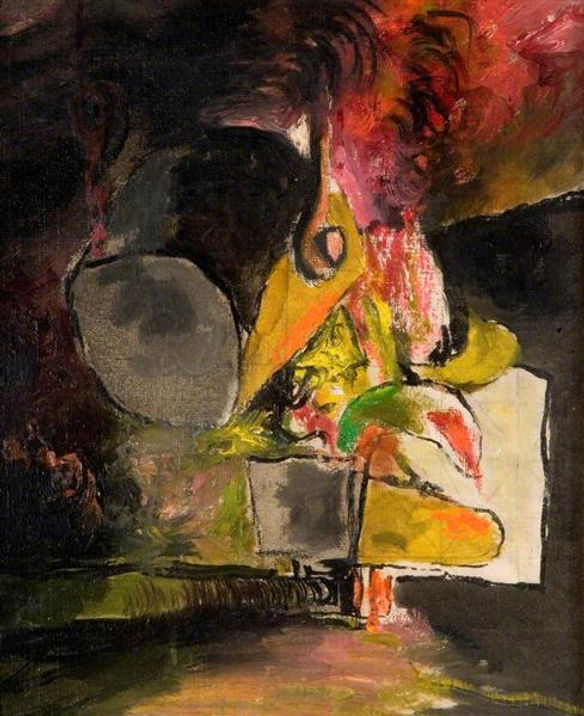
Graham Sutherland

Graham Sutherland

Graham Sutherland

Crucifixion
Graham Sutherland
1946

Graham Sutherland

Graham Sutherland

Graham Sutherland

Graham Sutherland

Graham Sutherland

Graham Sutherland

Graham Sutherland

Graham Sutherland

Graham Sutherland

Graham Sutherland

Graham Sutherland

Graham Sutherland
Salvador Dali
1904 – 1989

Dali. Self-portrait. 1921
Salvador Dali
Salvador Domingo Felipe Jacinto Dalí i Domènech, Marquess of Dalí of Púbol (11 May 1904 – 23 January 1989), known as Salvador Dalí, was a Spanish surrealist artist renowned for his technical skill, precise draftsmanship, and the striking and bizarre images in his work.
Born in Figueres, Catalonia, Spain, Dalí received his formal education in fine arts in Madrid. Influenced by Impressionism and the Renaissance masters from a young age he became increasingly attracted to Cubism and avant-garde movements. He moved closer to Surrealism in the late 1920s and joined the Surrealist group in 1929, soon becoming one of its leading exponents. His best-known work, The Persistence of Memory, was completed in August 1931, and is one of the most famous Surrealist paintings. Dalí lived in France throughout the Spanish Civil War (1936 to 1939) before leaving for the United States in 1940 where he achieved commercial success. He returned to Spain in 1948 where he announced his return to the Catholic faith and developed his "nuclear mysticism" style, based on his interest in classicism, mysticism, and recent scientific developments.
Dalí's artistic repertoire included painting, graphic arts, film, sculpture, design and photography, at times in collaboration with other artists. He also wrote fiction, poetry, autobiography, essays and criticism. Major themes in his work include dreams, the subconscious, sexuality, religion, science and his closest personal relationships. To the dismay of those who held his work in high regard, and to the irritation of his critics, his eccentric and ostentatious public behavior often drew more attention than his artwork. His public support for the Francoist regime, his commercial activities and the quality and authenticity of some of his late works have also been controversial. His life and work were an important influence on other Surrealists, pop art and contemporary artists such as Jeff Koons and Damien Hirst.

Girl at the Window, 1925

Apparatus and Hand
1927

The Enigma of Desire - my Mother, my Mother, my Mother
1929

The Lugubrious Game
1929

The Invisible Man
1929

Accomodations of Desire
1929

Imperial Monument to the Child-Woman, Gala
1929

Portrait of Paul Eluard
1929
Salvador Dalí and Gala

Dali and Gala
Gala Dalí
(born Elena Ivanovna Diakonova, Елéна Ивáновна Дья́конова; 7 September [O.S. 26 August] 1894 – 10 June 1982), usually known simply as Gala, was the wife of poet Paul Éluard and later of artist Salvador Dalí, who were both prominent in surrealism. She also inspired many other writers and artists.
With Éluard, Gala became involved in the Surrealist movement. She was an inspiration for many artists including Éluard, Louis Aragon, Max Ernst, and André Breton. Breton later despised her, claiming she was a destructive influence on the artists she befriended. She, Éluard, and Ernst spent three years in a ménage à trois, from 1924 to 1927. In early August 1929, Éluard and Gala visited a young Surrealist painter in Spain, the emerging Salvador Dalí. An affair quickly developed between Gala and Dalí, who was about 10 years younger than she. Nevertheless, even after the breakup of their marriage, Éluard and Gala continued to be close.
After living together since 1929, Dalí and Gala married in a civil ceremony in 1934, and remarried in a Catholic ceremony in 1958 in the Pyrenean hamlet of Montrejic. They needed to receive a special dispensation by the Pope because Gala had been previously married and she was a believer (not Catholic, but was an Orthodox Christian).[dubious – discuss] Due to his purported phobia of female genitalia, Dalí was said to have been a virgin when they met on the Costa Brava in 1929. Around that time she was found to have uterine fibroids, for which she underwent a hysterectomy in 1936. She was Dalí's muse, directly inspiring and appearing in many of his works.
In the early 1930s, Dalí started to sign his paintings with his and her name as "(i)t is mostly with your blood, Gala, that I paint my pictures". He stated that Gala acted as his agent, and aided in redirecting his focus. According to most accounts, Gala had a strong libido and throughout her life had numerous extramarital affairs (among them with her former husband Paul Éluard), which Dalí encouraged, since he was a practitioner of candaulism. She had a fondness for young artists, and in her old age she often gave expensive gifts to those who associated with her.
In 1968, Dalí bought Gala the Castle of Púbol, Girona, where she would spend time every summer from 1971 to 1980. He also agreed not to visit there without getting advance permission from her in writing.

Gala and Salvador Dali

Gala and Salvador Dali

Portrait of Gala by Salvador Dali

Portrait of Gala by Salvador Dali

Portrait of Gala by Salvador Dali

Gala and Salvador Dali

Portrait of Gala against the light by Salvador Dali

Portrait of Gala by Salvador Dali

Gala and Salvador Dali

Portrait of Gala by Salvador Dali

Salvador Dali “Gala, contemplating Corpus hypercubus”

Gala Nude looking in an invisible mirror by Salvador Dali

Gala and Salvador Dali

Galatea at the moment of creation. Salvador Dali

Salvador Dali “Portrait of Gala with rhinocene signs”

Gala and Salvador Dali

The Madonna of Port Lligat by Salvador Dali

Salvador Dali “Atomic Leda”

Gala and Salvador Dali
Un chien andalou
(An Andalusian Dog)
First Film by Bunuel and Dali
1928-1929
A Dagger in the Heart of Paris
The film made Bunuel and Dali famous overnight. They had planned to plunge it "right into the heart of witty, elegant and intellectualized Paris" - and even if Dali felt the audience that applauded the film was a jaded one, willing to applaud anything novel or bizarre, he was still happy to note the success in his Secret Life: "The film produced the effect that I wanted, and it plunged like a dagger into the heart of Paris as I had foretold. Our film ruined in a single evening ten years of pseudo-intellectual post-war advance-guardism. That foul thing which is figuratively called abstract art fell at our feet, wounded to the death, never to rise again, after having seen a girl's eye cut by a razor blade - this was how the film began. There was no longer room in Europe for the little maniacal lozenges of Monsieur Mondrian.

* * *

* * *

* * *

* * *

* * *

* * *
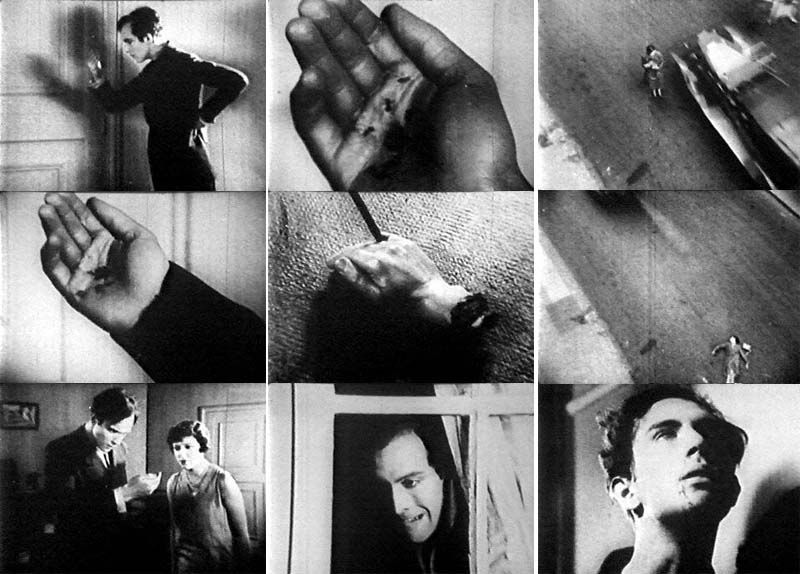
* * *

* * *

* * *
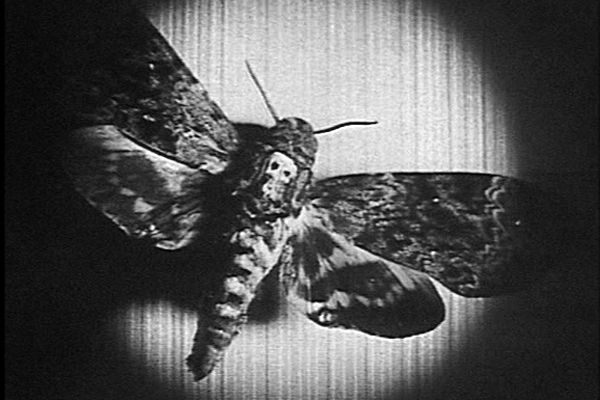
* * *

* * *

SALVADOR DALI:
THE ENIGMA OF WILLIAM TELL. 1933. Paris. Private Collecti

SALVADOR DALI: PARTIAL HALLUCINATION:SIX IMAGES OF LENIN ON A PIANO. 1931. Paris. MNAM

SALVADOR DALI: Invisible Sleeping Woman
1930

SALVADOR DALI: The Old Age of William Tell
1931

SALVADOR DALI: The Persistence of Memory
1931

SALVADOR DALI: The Dream
1931

SALVADOR DALI: Meditation on the Harp
1932-1934

SALVADOR DALI: The Ghost of Vermeer of Delft Which Can Be Used As a Table
1934

SALVADOR DALI: The Bust of a Retrospective Woman
1933

SALVADOR DALI:
THE KNIGHT OF DEATH. 1935. Paris. Private Collection

SALVADOR DALI: THE GREAT MASTURBATOR. 1929. Private Collection

Paranoiac Woman-Horse (Invisible Sleeping Woman, Lion, Horse)
Salvador Dali
1930

William Tell
Salvador Dali
1930

Remorse, or Sphinx Embedded in the Sand
Salvador Dali
1931

Angelus
Salvador Dali
1932

Archeological Reminiscence Millet's Angelus
Salvador Dali
1935

Face of Mae West Which May Be Used as a Surrealist Apartment
Salvador Dali
c.1935

Woman with a Head of Roses
Salvador Dali
1935
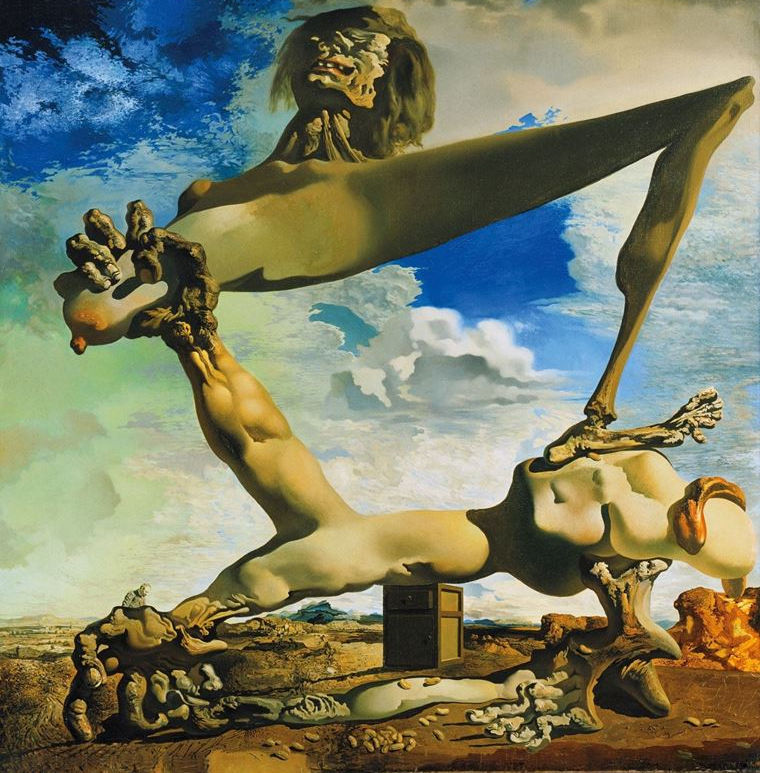
SALVADOR DALI:
SOFT CONSTRUCTION WITH BOILED BEANS (PREMONITION OF CIVIL WAR). 1936. Philadelphia. Museum of Art

SALVADOR DALI: SLEEP. 1937. Edward James Foundation

Dream Caused by the Flight of a Bee around a Pomegranate a Second before Awakening
Salvador Dali
1944

Tristan and Isolde
Salvador Dali
1944
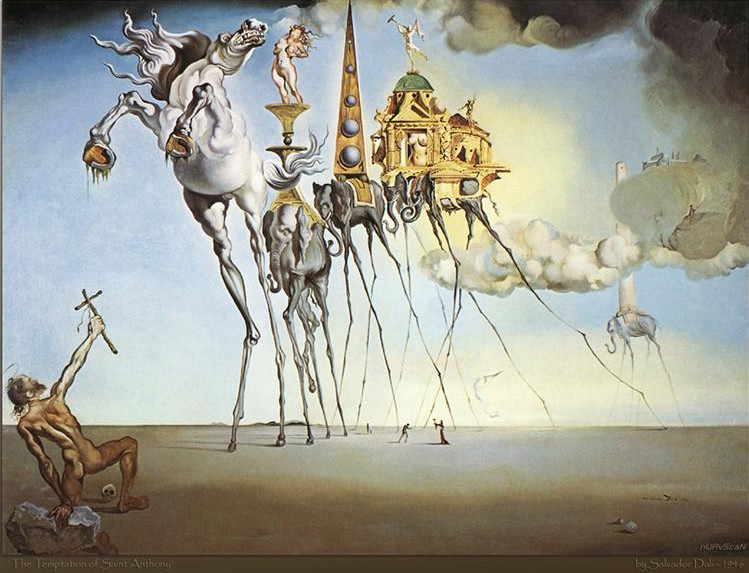
The Temptation of St. Anthony
Salvador Dali
1946

The Hallucinogenic Toreador (1968–1970) by Salvador Dali

Portrait of Picasso
Salvador Dali
1947
Salvador Dali's "Aliyah: The Rebirth of Israel"

Salvador Dali Portrait - By: Mark Ashkenazi

Introduction
Dali Jews flag Alyah

Exile and Hope
Dali_Exhile_and_Hope "A Voice is heard in Ramah"

Exile and Hope
Dali_Wailing_Wall The Wailing Wall
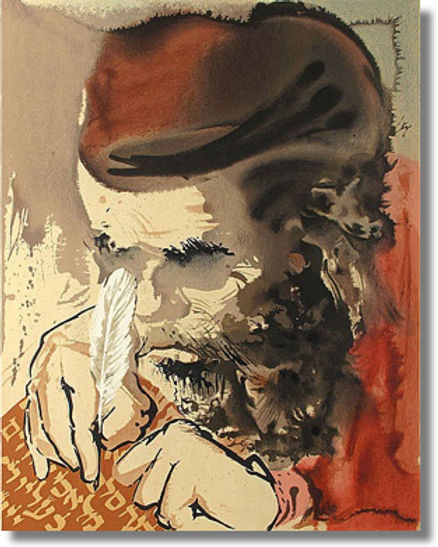
Exile and Hope
Dali_lenght_of_thy "For it is Thy Life and the Length of Thy Days"

Exile and Hope
Dali_Return_Virgin
"Return, O virgin of Israel. Return to these, Thy Cities" (Jeremiah 31:20)

The Yishuv: The Pre-State of Israel Settlement
"We Shall Go Up at Once and Possess It"
"We shall go up at once and possess it" (Numbers 13:30)
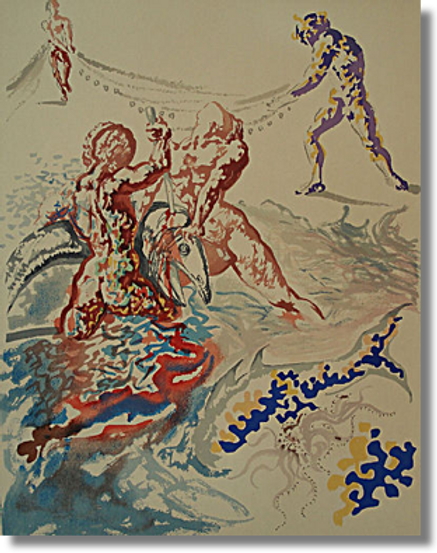
The Yishuv: The Pre-State of Israel Settlement
Dali_Land_and_Sea
"Let Them Have Dominion"
"Let them have dominion over the fish of the sea and over the fowl of the air and over the cattle and over every creeping thing" (Genesis 1:26)
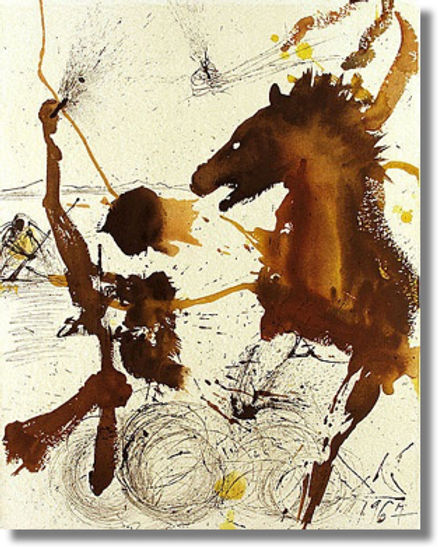
The Yishuv: The Pre-State of Israel Settlement
Dali_Pioneer_of_Israel
The Pioneers of Israel
"With one of his hands, he wrought the work and, with the other, held his weapon" (Nehemiah 4:11)

The Yishuv: The Pre-State of Israel Settlement
Dali_Illegal_Immigrants
On the Shores of Freedom
The Eliahu Golomb brings "illegal" immigrants.

The Yishuv: The Pre-State of Israel Settlement
"Arise, Barak, and Lead Thy Captives"

The Yishuv: The Pre-State of Israel Settlement
The Land of Milk and Honey

Shoah
Dali_Out_of_the_Depths
Out of the Depths

Shoah
"Thou Hast Laid Me in the Nethermost Pit"
"Thou hast laid me in the nethermost pit, in dark places, in the deeps" (Psalms 88:7)

Shoah
"I Have Set Before Thee Life and Death"
"I have set before thee life and death, the blessing and the curse; therefore, choose life that thou mayest live, thou and thy seed"
(Deuteronomy 30:19)

Independence
Dali_Ben_Gurion_Independence
A Moment in History: David Ben Gurion Reading the Declaration of Independence in
May 5, 1948

Independence
Hatikvah: Israel's National Anthem

Independence
Orah, Horah: Lights of Joy

Independence
Angels of Rebirth

Independence
The Battle of the Jerusalem Hills

Independence
Victory: A Song of Thanksgiving

Independence
The Price — Bereavement

The Final Image
Dali_Circumcision
Covenant Eternal: Circumcision

Galatea of the Spheres
Salvador Dali
1952
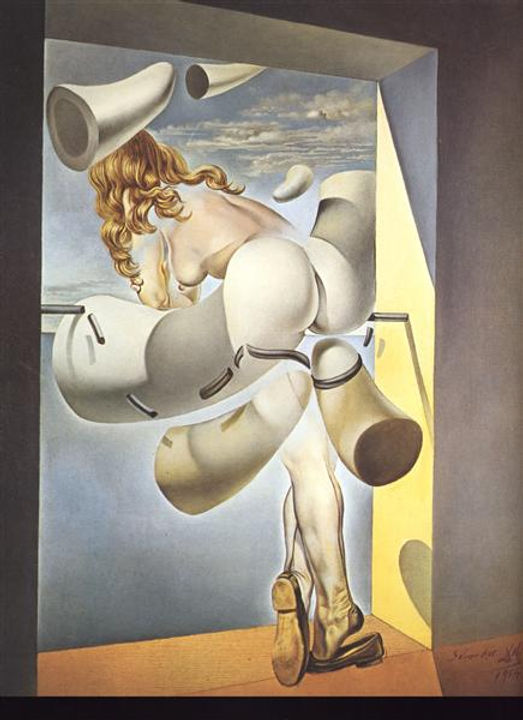
Young Virgin Auto-Sodomized by the Horns of Her Own Chastity
Salvador Dali
1954

Dali Nude, in Contemplation Before the Five Regular Bodies
Salvador Dali
1954

The Disintegration of the Persistence of Memory
Salvador Dali
1952 - 1954

Music-The Red Orchestra-The Seven Arts
Salvador Dali
1957

Hercules Lifts the Skin of the Sea and Stops Venus for an Instant from Waking Love
Salvador Dali
1963

Roger Freeing Angelica (St. George and the Damsel)
Salvador Dali
1970

Dali from the Back Painting Gala from the Back Eternalized by Six Virtual Corneas Provisionally Reflected in Six Real Mirrors
Salvador Dali
1972 - 1973

Gala Contemplating the Mediterranean Sea Which at Twenty Meters Becomes the Portrait of Abraham Lincoln - Homage to Rothko (first version)
Salvador Dali
c.1974 - c.1975

Dali Lifting the Skin of the Mediterranean Sea to Show Gala the Birth of Venus
Salvador Dali
Date: 1977

Dali's Hand Drawing Back the Golden Fleece in the Form of a Cloud to Show Gala,Completely Nude,the Dawn,Very,Very Far Away Behind the Sun
Salvador Dali
1977

Dalì holding a mannequin, International Surrealist Exhibition, Paris, 1938. Photo: Denise Bellon

Salvador Dali with mannequins at the Surrealist Exhibition, Paris

Dalí Atomicus, photo by Philippe Halsman (1948)

Dalí Atomicus, photo by Philippe Halsman (1948)

Salvador Dali By PHILIPPE HALSMAN

Women forming a skull
Salvador Dali
Philippe Halsman
1951

Women forming a skull
Salvador Dali
Philippe Halsman
1951

Women forming a skull
Salvador Dali
Philippe Halsman
1951

Philippe Halsman (American, 1906-1979)
Portrait de Salvador Dalí avec casque de footballeur américain (Portrait of Salvador Dalí with American football helmet)
1964

Philippe Halsman
Dalí Cyclops
1949

Dali and Rhinoceros
Philippe Halsman

Philippe Halsman
Like Two Erect Sentries, My Mustache Defends the Entrance to My Real Self, Dalí’s Mustache
1954

Philippe Halsman
Nu au pop-corn (Popcorn nude)
1949

Philippe Halsman - Dali is painting medusas head on Galas forehead

Salvador Dalí in bed
Philippe Halsman
1964

1954 Vintage Salvador Dali Mona Lisa Surreal Photo Art By PHILIPPE HALSMAN

Salvador Dali By PHILIPPE HALSMAN

Salvador Dali By PHILIPPE HALSMAN

Salvador Dali By PHILIPPE HALSMAN

Salvador Dali By PHILIPPE HALSMAN

Salvador Dali By PHILIPPE HALSMAN

Salvador Dali By PHILIPPE HALSMAN
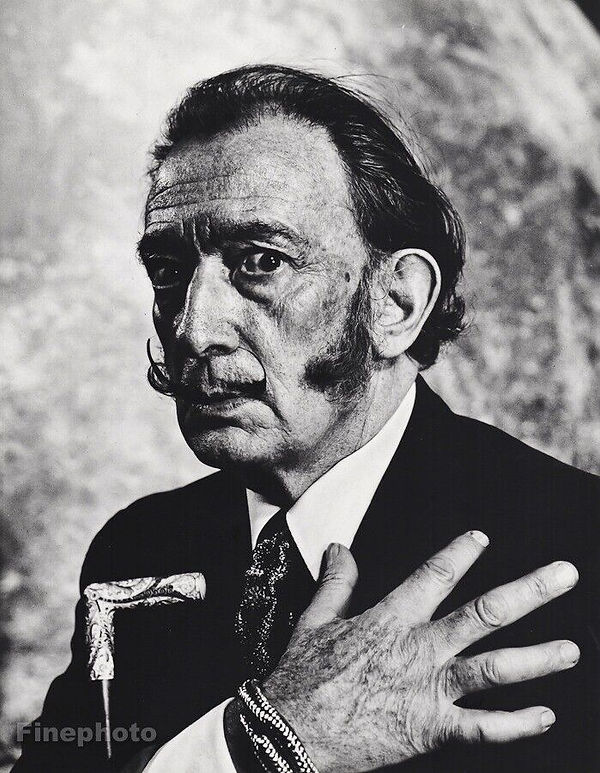
Salvador Dali By PHILIPPE HALSMAN
Felix Labisse
1905 – 1982

Felix Labisse
(March 9, 1905 – January 27, 1982) was a French Surrealist painter, illustrator, and designer.
He was born in Marchiennes. He divided his time between Paris and the Belgian coast from 1927. In Ostend he met James Ensor, who influenced his work. Beginning in 1931 he designed for the theater. His paintings depict fantastical hybrid creatures, and are often erotic. He painted the first of a series of blue women in 1960; among them is the Bain Turquoise.
He was the subject of a film by Alain Resnais, Visite à Félix Labisse (1947). In 1966 he was elected to the Académie des Beaux-Arts. In 1973 his paintings were shown in a retrospective exhibition at the Museum Boijmans Van Beuningen, Rotterdam. He died in Neuilly-sur-Seine in 1982.
Félix Labisse

Félix Labisse

Félix Labisse

Félix Labisse

Félix Labisse

Félix Labisse

Félix Labisse

Félix Labisse

Félix Labisse

Félix Labisse

Félix Labisse

Félix Labisse

Félix Labisse

Félix Labisse

Félix Labisse
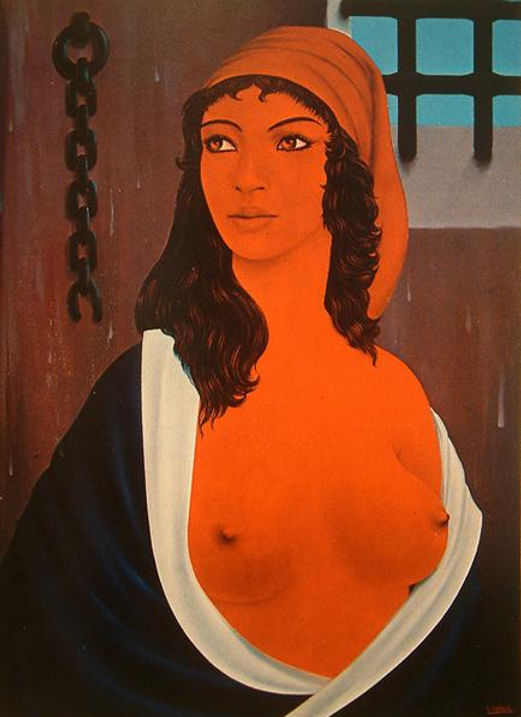
Félix Labisse

Félix Labisse

Félix Labisse
Wolfgang Paalen
1905 – 1959

Wolfgang Robert Paalen
(July 22, 1905 in Vienna, Austria – September 24, 1959 in Taxco, Mexico) was an Austrian-Mexican painter, sculptor, and art philosopher. A member of the Abstraction-Création group from 1934 to 1935, he joined the influential Surrealist movement in 1935 and was one of its prominent exponents until 1942. Whilst in exile in Mexico, he founded his own counter-surrealist art-magazine DYN, in which he summarized his critical attitude towards radical subjectivism and Freudo-Marxism in Surrealism with his philosophy of contingency. He rejoined the group between 1951 and 1954, during his sojourn in Paris.

Les tours de lumière
Wolfgang Paalen
1936

Fumage
Wolfgang Paalen
1937

Forbidden Land
Wolfgang Paalen
1937

Les etrangers
Wolfgang Paalen
1937

Genius of the Species
Wolfgang Paalen
1938

Ciel de pieuvre
Wolfgang Paalen
1938

Combat des Princes Saturniens III
Wolfgang Paalen
1939

Messenger from the Three Poles
Wolfgang Paalen
1949
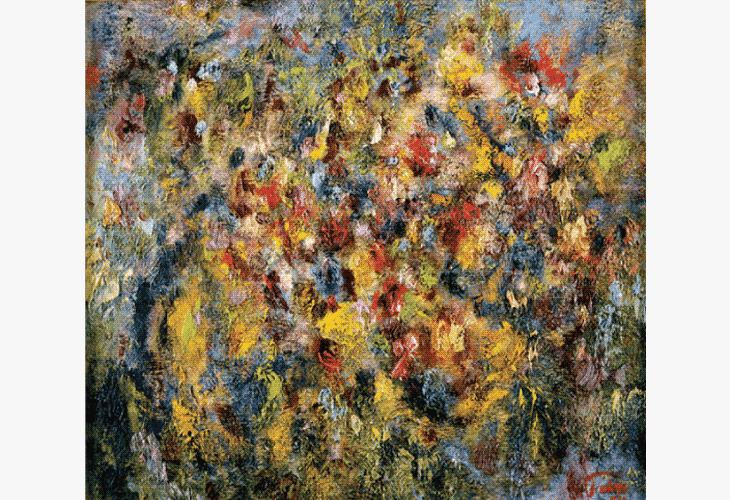
That's life
Wolfgang Paalen
1958
Aaron Bohrod
1907 – 1992
Aaron Bohrod
(21 November 1907 – 3 April 1992) was an American artist best known for his trompe-l'œil still-life paintings.
Bohrod was born in Chicago in 1907, the son of an emigree Bessarabian-Jewish grocer. Bohrod studied at the School of the Art Institute of Chicago and the Art Students League of New York between 1926 and 1930. While at the Art Students League, Bohrod was influenced by John Sloan and chose themes that involved his own surroundings.
He returned to Chicago in 1930 where he painted views of the city and its working class. He eventually earned Guggenheim Fellowships which permitted him to travel throughout the country, painting and recording the American scene. His early work won him widespread praise as an important social realist and regional painter and printmaker and his work was marketed through Associated American Artists in New York. Bohrod completed three commissioned murals for the Treasury Departments Section of Fine Arts in Illinois; Vandalia in 1935, Galesburg in 1938 and Clinton in 1939. During World War II, Bohrod worked as an artist; first in the Pacific for the United States Army Corps of Engineers' War Art Unit, then in Europe for Life magazine. In 1948, he accepted a position as artist in residence, succeeding John Steuart Curry, at the University of Wisconsin–Madison, and remained in that capacity until 1973. In 1951, Bohrod was elected into the National Academy of Design as an Associate member, and became a full member in 1953. He died from liver cancer at his home in Madison, Wisconsin on 3 April 1992, at the age of 84.
.

Aaron Bohrod
Self Portrait

Aaron Bohrod

Aaron Bohrod

Aaron Bohrod

Aaron Bohrod

Aaron Bohrod

Aaron Bohrod

Aaron Bohrod

Aaron Bohrod

Aaron Bohrod
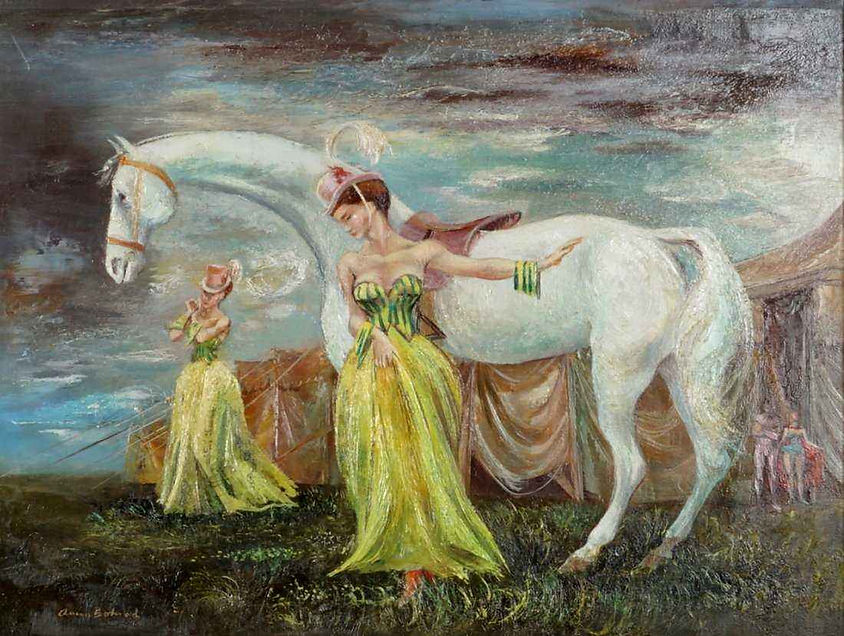
Aaron Bohrod

Aaron Bohrod

Aaron Bohrod

Aaron Bohrod

Aaron Bohrod

Aaron Bohrod

Aaron Bohrod

Aaron Bohrod

Aaron Bohrod

Aaron Bohrod

Aaron Bohrod

Aaron Bohrod

Aaron Bohrod

Aaron Bohrod

Aaron Bohrod